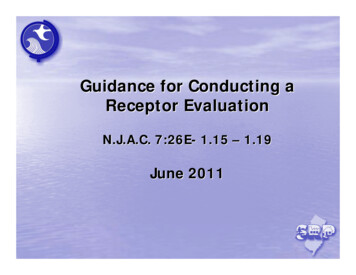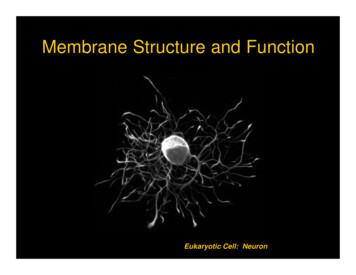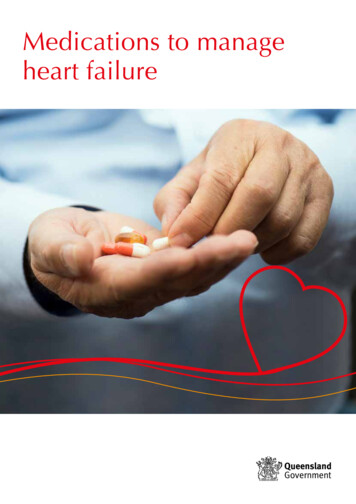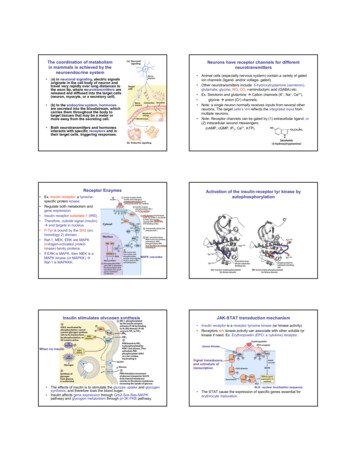
Transcription
Guidance for Conducting aReceptor EvaluationN.J.A.C. 7:26E- 1.15 – 1.19June 2011
Receptor Evaluation GuidanceCommitteeSteve Maybury NJDEPDave Barskey NJDEPRenee Wright NJDEPNeil Rivers Langan Engineering & Env. ServicesPhilip I. Brilliant Brilliant Env. Services LLC
Purpose of a receptor evaluation? To ensure an ongoing evaluation process To ensure that the protection of receptors is ourtop priority by requiring– Early identification of receptors at or near the site– Evaluation of all contaminant migration pathways– Receptor sampling when contamination is within triggerdistances/criteria– Evaluation and implementation of response actions toprotect human health in a timely manner
Receptor Evaluation ProcessVsReceptor Evaluation ( RE) Form During the RE process the LSRP must focuson collection of data and conduct anongoing evaluation of receptors The RE Form is a compliance evaluationtool only
When does the Receptor EvaluationProcess Start and End? The RE process starts– When “Remediation is Initiated” i.e., when adischarge is confirmed or ISRA is triggered The RE process ends When a unrestricted remedial action iscompleted, or When a restricted or limited restricted remedialaction is completed (includes a RA Permit) The Biennial Certification takes the placeof the RE Form
Regulatory Time Frames for theinitial RE Form For Existing Cases - March 1, 2011 (initiatedremediation before March 1, 2010)Are all your cases in compliance? For New Cases - 1 year after remediation is initiated(initiated remediation after March 1, 2010) Update the RE Form with the submission of each“milestone” document Time frame extensions
Specific Regulatory Time FramesBased on Environmental Conditions Potable Water– 90 days to conduct well search– 120 days to sample wells Vapor Intrusion– 60 days to evaluate structures– 150 days to sample potentially impacted structures Use the Regulations, RE Quick Reference Guide andthe Summary of Regulatory and Mandatory TimeFrames on the DEP website
Mandatory Time Frames for theInitial RE Form For Existing Cases - March 1, 2012 (initiatedremediation before March 1, 2010) For New Cases - 2 years after remediation isinitiated (initiated remediation after March 1, 2010) Time frame extensions Non-compliance Direct Oversight (Shall)
What should you use to ensurecompliance? Technical /techrule.pdf Quick Reference matrix/new responsibilities/receptor eval.pdf rintrusion/faqs.htm RE Form & rms/receptor evaluation s/receptor evaluation report ins.pdf
Section by Section Guidance Land use Description of Contamination Groundwater use New spreadsheet and well search guidance Vapor Intrusion IECs Vapor Concern Conditions Ecological
General Concepts - Timing Start the Receptor Evaluation early, andupdate it routinelyIt’s not just about completing the form, it’sabout an ongoing assessment process toidentify and protect receptors.
Similarities Between RE andConceptual Site Model (CSM) Develop early in project Identify sources, migration pathways andpotential receptors Iteratively update as new information isdeveloped
General Concepts – The RE Form Form is intended to document the REstatus and ensure completeness. FAQs and instructions will answer mostquestions. Justification should be focused and brief.
Initial vs. Interim Initial – All Cases– Is the first RE form submitted for a case– Even if previous reports contained well search,BEE, etc.– Brief Summary of Contaminant Data - Summarytable/figure Interim – All Cases– Is any subsequent submission of the RE form– Remedial Investigation Report– Remedial Action Report
Land UseWho may be or become exposed tocontamination from the site? Identify potential receptors Current land use Identify planned land use changes over time
Land Use Identify all land-use at site and within 200feet of property boundary– Visual, maps, etc.– Degree of Certainty– Large site/Single AOC – variance – See FAQ Locate sensitive populations within 200 feeton a scaled map– Residence, school, child care center, playground,park, other recreation
Ground Water UseInitial Well Search Required when ground water contamination isdetected at concentration greater than theGround Water Remediation Standards Initial low level exceedances can beconfirmed first (within 30 days).
Ground Water UseInitial Well Search Identify and map– All wells within ½ mile of known extent– All public supply, irrigation and industrial wellswithin 1 mile of known extent– Not required to map monitoring wells Submit hard copy of entire well search withnext milestone report Submit spreadsheet only with theRE Form
Initial Well Search Resources NJDEP GIS– Public Supply Wells– Well Head Protection Areas– Water Purveyor Service Areas NJDEP Well Records– Bureau of Water Allocation Paper search Electronic search NJDEP Well Records on line County & Local Records
Initial Well Search Resources NJDEP GIS– Public Supply Wells– Well Head Protection Areas– Water Purveyor Service Areas NJDEP Well Records– Bureau of Water Allocation Paper search Electronic search NJDEP Well Records on line County & Local Records
Well Search Spreadsheet 101 Electronic well search More efficient and focused way to identifywells Helping to amass a library of accurate welllocations “How to” video
Assessing Well Search Records Determine well locations vs. plume extent Conduct a visual survey of the area– Reconcile well search data– Water supply lines– Vacant properties
Assessing Well Search Records Door-to-door survey– Potable wells in ½ mile– Do when there is uncertainty about groundwater use in the area Door-to-door can be modified based on– Known ground water flow direction– Plume delineated
Well Sampling Within 120 days, sample all potable wells within1,000 feet of ground water contamination– If ground water flow direction is known maylimit sampling to 250 feet upgradient 500 feet sidegradient 1,000 feet downgradient Should sample “worst first” and work your way out Irrigation wells if exposure concern
Well Sampling Notify DEP prior to sampling (form) Step out until clean wells are found Report results to DEP– For exceedances – Follow IEC requirements– No exceedances – Report in 14 days
Vapor Intrusion (VI) VI investigation triggers in Tech Rule– Ground water contamination 30 feet of a building (petroleum products) 100 feet of a building (all other volatile compounds)– Free product 100 feet of a building (except for # 2fuel oil or diesel)– Soil gas or indoor air impacts above VI screeninglevels– On-site landfills– Methanogenic conditions
Vapor Intrusion Investigation Within 60 days of the trigger– Identify structures and utilities– Determine ground water flow direction Within 150 days of the trigger– Implement VIG/sampling
Vapor Intrusion Investigation Notify DEP prior to indoor or sub-slabsampling (form) Report results to DEP– For exceedances – Follow IEC requirements– No exceedances – Report in 14 days
VI – Mapping utilities FAQ Map laterals servicing larger buildings(apartment, commercial, industrial) Map main lines servicing groups ofresidential developments Map utility vaults and other undergroundstructures
Vapor Intrusion – mapping utilities Interim approach pending VIG update For single family homes/townhomes– Assume service lines run to each structure– Therefore, mapping is not needed
Ecological Conduct a Baseline Ecological Evaluation(BEE) pursuant to N.J.A.C. 7:26-3.11 Report on the RE form that the BEE wasconducted Update BEE as more data is collected andEco Conceptual Site Model (CSM) is refined– Sources– Migration pathways– Ecological receptors
Problems identified by reviewers Incomplete forms being submitted The wording of some questions may beconfusing Many LSRPs are leaving questions blankWhen in doubt about how to answer?Attach a written explanation
Receptor Evaluation Guidance Committee Steve Maybury NJDEP Dave Barskey NJDEP Renee Wright NJDEP Neil Rivers Langan Engineering & Env. Services Philip I. Brilliant Brilliant Env.










